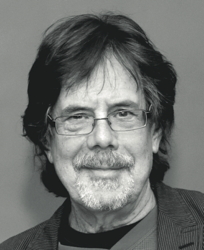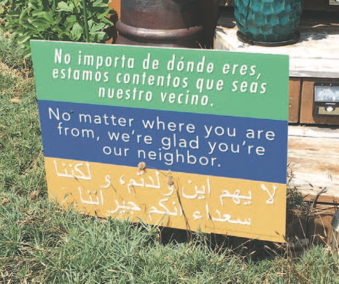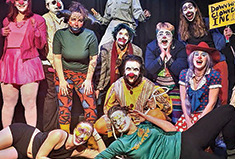Peter Werbe : A Sign to Be Proud Of
By PETER WERBE
 ACROSS THE CITIES SERVED BY FERNDALE FRIENDS, lawn signs are displayed welcoming immigrants to our communities. What they proclaim are an echo of he familiar words mounted on the base of the Statue of Liberty—“Give me your tired, your poor. . .”
ACROSS THE CITIES SERVED BY FERNDALE FRIENDS, lawn signs are displayed welcoming immigrants to our communities. What they proclaim are an echo of he familiar words mounted on the base of the Statue of Liberty—“Give me your tired, your poor. . .”
In Ferndale, Oak Park and beyond, the signs on our lawns state in three languages, “No matter where you are from, we’re glad you’re our neighbor.” These public pronouncements define communities committed to diversity, tolerance, and a charity of heart.
The “mighty woman with a torch,” as the full poem reads, reaches 305 feet into the sky, calling out a welcome to the “huddled masses” and “wretched refuse” to our shores.
Wonderful words, but rarely honored as we are witnessing today at the U.S. southern border. American history wasn’t much better on welcoming immigrants to our country either. In fact, from the first wave of European migrants, the new arrivals were despised and discriminated against.
Other than those from Northern Europe, many of our ancestors were accused of being the source of crime, disease, and social unrest, much in the way those from Central and South America are today by some. Although, it is well-known that current immigrants commit less crime than those born here, this doesn’t stop right-wing politicians from whipping up frightened Americans with images of criminal gangs and job theft.
The lower crime rate is actually somewhat surprising. Earlier ethnic groups often were disproportionately represented in law-breaking. The Irish (part of my heritage) were the targets of great discrimination, giving rise to signs saying, “No Irish need apply” at job sites, leading to lives of poverty and high crime rates.
Following their mass migration here in the 1840s and ‘50s, so many poor Irishmen were hauled off to jail that the police vehicle employed was dubbed a Paddy Wagon, using the word which became an anti-Irish slur stemming from the nickname for Pádraig (Patrick when Anglicized). And, just as the racist stereotyping of all Muslims results from the actions of a tiny fraction of those of the faith, so too were Irish thought to be more loyal to the Pope in Rome than their new country.
This was reinforced during the 1846-48 U.S. ware against Mexico, when hundreds of newly arrived Irishmen were gang-pressed into the American army. Hundreds of Dubliners deserted from the U.S. war of aggression and fought on the Mexican side, organizing themselves as the St. Patrick’s Battalion. These “red-headed fighters” battled American troops alongside the Mexican army from Metamoros to San Diego, finally falling to “the cannons from Boston,” as David Rovics’ lyrics puts it in his song about the Battalion. (Available at DavidRovics.com.)
As an aside, when condemning Russia’s inexcusable annexation of Crimea and eastern Ukraine, we should consider the massive territory theft of Mexican territory—California, Arizona, New Mexico, and Texas. Putin’s moves are small change compared to that.
Other immigrating ethnic groups fared no better, being seen by the native born as people constantly under suspicion of crime and political radicalism. This included groups such as Jews (part of my heritage) and Italians, who upon arriving provided enough of their members involved in both to maintain stereotypes.
Although only an infinitesimal small number participated in criminal gangs, Italians in the Mafia and Jews in mobs like Detroit’s Purple Gang, they were often held to be representative of the entire nationality. For instance, in 1908, the New York City police commissioner claimed erroneously that half of the city’s criminals were Jewish.
Many Jewish immigrants were members of communist, socialist, and anarchist groups during the early years of the 20th Century, fueling anti-Semitism and a perception of disloyalty. Some recently arrived Italians were part of violent anarchist groups that carried out a string of bombings in the WWI era, including targeting Wall Street, and the homes of the U.S. Attorney General, and oil magnate, John D. Rockefeller.
Legislation such as the 1882 Chinese Exclusion Act and the Immigration Act of 1924 gave lie to the Lady of the Harbor’s call to “Send these, the homeless, tempest-tossed to me.”
PEOPLE NOT WELCOMED, HELD IN CONTEMPT, DISCRIMINATED AGAINST, and stereotyped, find it difficult to integrate into their new homeland – which is why the signs appearing on our lawns are so important. In the tumultuous days of the early 20th Century, there was no one to say, “We’re glad you’re our neighbor.”
The early immigration waves came as a result of wars, famine, and poverty, and it is no less so today with those crossing the border from South and Central America. Rather than erecting a wall as a ridiculous way to stem illegal immigration, how about enacting a hemisphere-wide minimum wage of $15? Workers from Detroit to Guadalajara would see a rise in their standard of living and the corporations which currently benefit from paying slave wages would pay for it.
This alone would go a long way towards staunching the poverty and violence that is endemic to poor regions and cities, and could end the tide of migration. The poverty and violence of a century ago and that of today is what impels waves of immigrants to flee their homeland.
A huge redistribution of wealth in the form of an increased wage might mean that Richie Rich Guy won’t be able to buy a second Maserati or own his own island, but prosperity for all is the key to having stable, livable cities and countries.
So, let’s keep those signs up until our brothers and sisters from the Middle East, Africa, and Latin America are allowed to take their place in our society in the same manner as were our forebears.
Peter Werbe is a member of the Fifth Estate magazine’s editorial collective www.FifthEstate.org.



